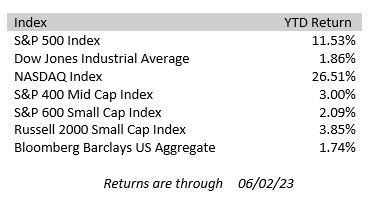The riveting debt ceiling story last week had the world watching to see if the U.S. could find compromise within its government leaders and avoid default on its debt. While both sides of the aisle had to make concessions to get a deal done under the wire, in the end the agreement between President Biden and Speaker McCarthy passed the House Wednesday, was approved by the Senate Thursday, and then was signed into law by the President, all in one week. This allowed global markets to breathe a sigh of relief and U.S. stock markets took off.
The Dow Jones industrial average was up 2.02% for the week. The S&P 500 followed suit gaining 1.83%, and the NASDAQ rose 2.04% for the week. Meanwhile, Mid-Caps and Small-Caps increased 2.50% and 3.15%, respectively.
The other major headline fueling markets last week was another strong monthly employment report as May’s job gains came in at 339k, well beyond expectations of 195k. In addition, the prior two months’ net payrolls were revised up 93k. Despite the large jobs gain, the unemployment rate jumped to 3.7% from 3.4% and hourly earnings dropped to 4.3%. Initial claims for unemployment came in at 232K, which was a little higher than the previous week of 230K, but lower than expected. Altogether, the jobs data boosted investor sentiment as it displayed continued strength and resiliency of the U.S. labor market, while also showing some progress in loosening from ultra-tight hiring conditions that have underpinned wage inflation. However, labor conditions likely remain too tight for comfort for the Fed in achieving its 2% inflation target. This first major release before the June FOMC meeting is leading to a small chance that the Fed may increase rates 25 bps in June and possibly July instead of holding rates the same.
In other economic news, activity in the manufacturing sector continued to soften last month. The ISM Manufacturing Index was 46.9% for May, down from April at 47.1%. May marked the seventh straight monthly contraction. The Markit PMI Manufacturing (the U.S. Services Purchasing Manufacturers Index) for May came in at 48.4%, just 0.10% lower than the previous month. Both readings fell short of the 50% mark showing expansion.
A couple more quick mentions from last week include Saudi Arabia announcing an additional 1M bpd production cut with the news of OPEC+ agreeing to extend voluntary cuts by one year. Also, Allstate (ALL) is the latest insurer to halt new home and commercial insurance policies in California.
This week should be a lot quieter than last. Giving everyone an opportunity to digest last week’s whirlwind of activity. Durable orders are not expected to change from April. Factory orders are expected to double from 0.40% to 0.80%. Trade balance is expected to increase from-$64.2B to -$74.4B.



